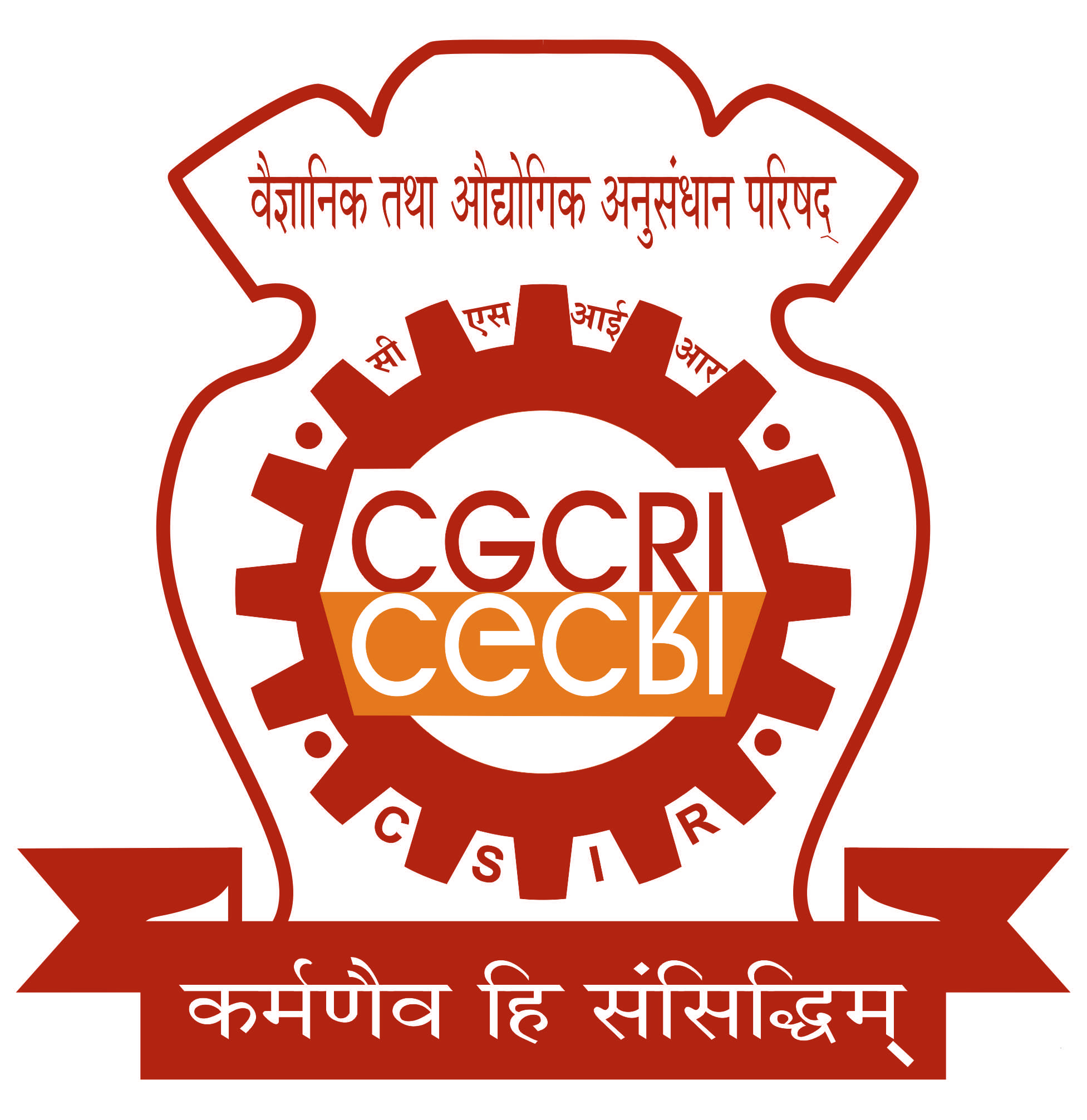English | हिन्दी

সিএসআইআর-কেন্দ্রীয় কাঁচ ও সেরামিক গবেষণা সংস্থা
सीएसआईआर-केंद्रीय काँच एवं सिरामिक अनुसंधान संस्थान
CSIR-Central Glass & Ceramic Research Institute

Disclosure
CSIR-Central Glass and Ceramic Research Institute (CSIR-CGCRI)
CGCRI was established in the year 1950 as a National Laboratory to carry out R & D in the areas of glass and ceramics catering to the needs of the industry and the society for these two types of materials. It is the only organisation in India fully dedicated to R & D work on glass, ceramics and allied fields.
In the initial phase, the activities of the Institute were concerned with optical glass and refractory materials. Over the years it has developed expertise in such important areas as fibre-optics, ceramic membrane, bio-ceramics, engineering ceramics, solid oxide fuel cell, ceramic based sensors, speciality glass (such as radiation resistant, laser and zero expansion types).
Glass
The activities grouped under Glass Science, Glass Technology and Specialty Glass Processing encompasses a team of researchers carrying out advanced research on glasses for special use. The Institute has undertaken the engineering design to translate a laboratory process of making of special glass to an automated process for making glass blocks of various desired sizes.
A novel way of using glass as fertilizer is being developed utilizing its not-so-known properties. Micro-nutrient glasses containing requisite quantities of nutrients e.g. potassium, calcium, sulphur can be used as controlled release fertilizers to grow several oil bearing seeds such as mustard oil, rapeseed, peanuts etc because of their controlled leaching characteristics in presence of water. Several such glass compositions have been developed by CGCRI and tested under field conditions.
Fibre Optics & Photonics
The Institute has a unique indigenous capability for fabrication of various types of optical fibres particularly in the laboratory and proto-type scale. Having earlier developed the common varieties of single and multi-mode communication grade fibres, the group is currently concentrating on high value low volume specialty fibres for communication as well as sensor applications for both civilian and strategic applications in defence, space, atomic energy etc. The future activities would include photonic crystal fibres, non-linear optics and polymer based optical fibres. Recently, the group has developed a commercial optical amplifier for cable TV network. An industrial partner to this project is successfully marketing the product. Another significant development has been the start of an Indo-Norwegian programme on the monitoring of temperature and sagging in power transmission lines by the use of FBG based sensors.
Sol-Gel
The primary emphasis of this group is to derive special properties in glass and ceramics in the form of nano-powders, coating and fibres, which are not possible (or are more difficult and expensive) through other methods of preparation and consolidation. Some of the important examples of achievements from this group are : (i) anti-reflective and antiglare coatings on glass surfaces (ii) Organic-inorganic nano composite films for various applications such as in bio-photonics, non-linear optics, laser damage tolerance, scratch resistance of plastics, IR reflection by window glasses etc, (iii) high purity silica glass, (iv) development of zirconia micro-spheres for plasma spraying.
Clay & Traditional Ceramics
As part of its societal obligations, CGCRI has built up an impressive expertise and knowledge base which are used, among others, on the upgradation of the skills and the production methods of traditional items like crockery, tiles and sanitary ware, so that their products can become competitive in the market in terms of quality and economics. The activity has a very strong industrial bias and accordingly, the Institute has, over the years, made a significant contribution in the technological upgradation of a large number of small and medium scale industry clusters all over the country particularly in UP, Gujarat, West Bengal, Kerala, MP, Tamil Nadu, HP and North Eastern States.
In a recent significant development, CGCRI has initiated production of bone-china crockery items in a rural setting in the Ceramic Centre for Rural Development (CCRD) in Panchmura in the Bankura District of West Bengal ions, CGCRI has built up an impressive expertise and knowledge base which are used, among others, on the upgradation of the skills and the production methods of traditional items like crockery, tiles and sanitary ware, so that their products can become competitive in the market in terms of quality and economics. The activity has a very strong industrial bias and accordingly, the Institute has, over the years, made a significant contribution in the technological upgradation of a large number of small and medium scale industry clusters all over the country particularly in UP, Gujarat, West Bengal, Kerala, MP, Tamil Nadu, HP and North Eastern States.
In a recent significant development, CGCRI has initiated production of bone-china crockery items in a rural setting in the Ceramic Centre for Rural Development (CCRD) in Panchmura in the Bankura District of West Bengal.
Refractories
Over the last few decades, the group has worked on several industry-funded projects and transferred a large number of technologies to Indian refractory manufacturers, covering a wide spectrum of materials e.g. fireclay, mica, rice husk ash, dolomite, magnesia, spinel, zirconia, synthetic mullite from beach sand etc. Technologies for both shaped and unshaped refractories have been developed and transferred to industries. Utilization of industrial wastes has been another area of strength of this group.
Ceramic Membranes
Based on the high application potential of ceramic membrances in a wide spectrum of industries e.g. water purification, food processing, pharmaceuticals, dairy, beverage, leather processing etc., the activity has grown at an extra-ordinary speed over the last few years. The main thrust has so far been on the removal of arsenic and iron from water. The demonstration and the pilot plants have been established in a large number of places in West Bengal. Plants are planned in the North eastern states, Sikkim and Bangladesh. Future programme includes the separation of heavy components from rice bran oil.
Nano-porous ceramic is now an emerging area of Materials Science encompassing ultra to nano-filtration membranes with diversified application potential in food processing industries particularly, purification of vegetable oil, concentration of sugar cane juice and other fruit juices, concentration of milk, whey, beverages etc. CGCRI is carrying out R & D activities in this area.
Non-Oxide Ceramics
In contrast to oxide ceramics, the sintering of non-oxide ceramic materials poses difficult problems. Knowledge base exists in CGCRI to overcome these problems _ either through the use of special binders, precursors and liquid infiltration. Important items based on C-SiC composite. BN and BN-Silica composites have been supplied to strategic sectors.
Presently the R & D activities are on silicon nitride based filter. In the future, a major activity is planned to be undertaken to develop silicon carbide substrated mullite membrane high temperature filter candles for separation of fly ash particles from coal gas.
Bioceramics & Coating
Hip-joint prosthesis and artificial eye-balls developed by this Institute and successfully implanted in a large number of patients have brought new lease of life to all of them. Both these implants are having huge demands. A number of other implants including dental implants, bio-active ceramic coatings on existing metallic implants are under development and are expected to be commercialised in near future.
With initial success of bio-ceramic research at CGCRI, efforts are directed to develop different types of innovative implants and devices, drug delivery systems, sensors, tendons, ligaments, artificial organs etc. The main emphasis would be on (i). development of different types of ceramic based biological implants _ orthopaedic and dentistry, cranio-facial, ENT, Ophthalmology and other applications, (ii). development of nano-grained ceramics and composites with exotic properties which may be coupled with other polymer/metallic components, (iii). development of different ceramic-polymer, ceramic-organic matter composites with tailored properties not only to repair the damaged bone but also to serve many functional properties.
Sensor & Actuator
Tin-dioxide based semi-conductor sensors for detection of methane and carbon mono-oxide have been developed jointly with an industry. The performance has been satisfactory as found on the basis of field trials carried out at CMRI, Dhanbad, Similarly, CGCRI has developed SnO2 based compact sensor for application in nuclear industry and humidity meter based on thick film ferroelectric lead magnesium niobate are also being pursued.
Fuel Cell and Battery
The increasing demand for maintaining a pollution free environment and alarming rate of depletion of fossil fuels have lead to intense R & D on clean and efficient power generating systems based on renewable sources of energy. Among many alternatives, the utilization of gaseous fuels for the production of energy is emerging as an efficient method of converting chemical energy to electrical energy. Fuel Cells are electrochemical systems that convert gaseous fuels directly to electrical power. Among different types of fuel cells, Solid Oxide Fuel Cell (SOFC) has been identified as one of the most promising technologies of the future due to its high energy conversion efficiency. Hydrogen has emerged as a non-polluting multipurpose fuel for our future fuel needs.
Nano-Structured Materials
This division has been established to focus activities related to the development of different functional nanomaterials and nanocomposite coatings of technological importance. Areas such as optically active (heat-absorbing, colored, reflective and anti-reflective) coatings, nanoparticles of metal/metal-alloy/core-shell configuration embedded in films, hydrophobic coatings, hard-coatings plastics, mixed-ion semiconducting oxides and single phase multiferroics are of special importance. Apart from generating useful knowledge-base on the synthesis of nanomaterials and their properties, inorganic-organic hybrid nanocomposite based technologies such as ‘anti-scratch coatings on plastic ophthalmic lenses’ (already commercialized), ‘hard¬coatings on polycarbonate sheets (2′ x 2′)’, ‘anti-reflective coating on plastic lenses and sheets’ have been developed.
Last Updated on January 16, 2020









